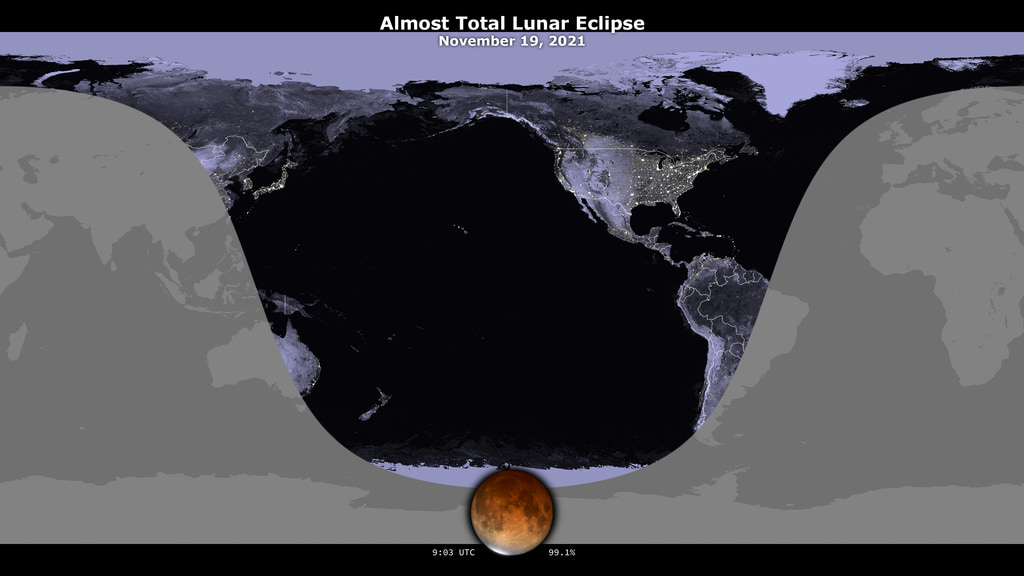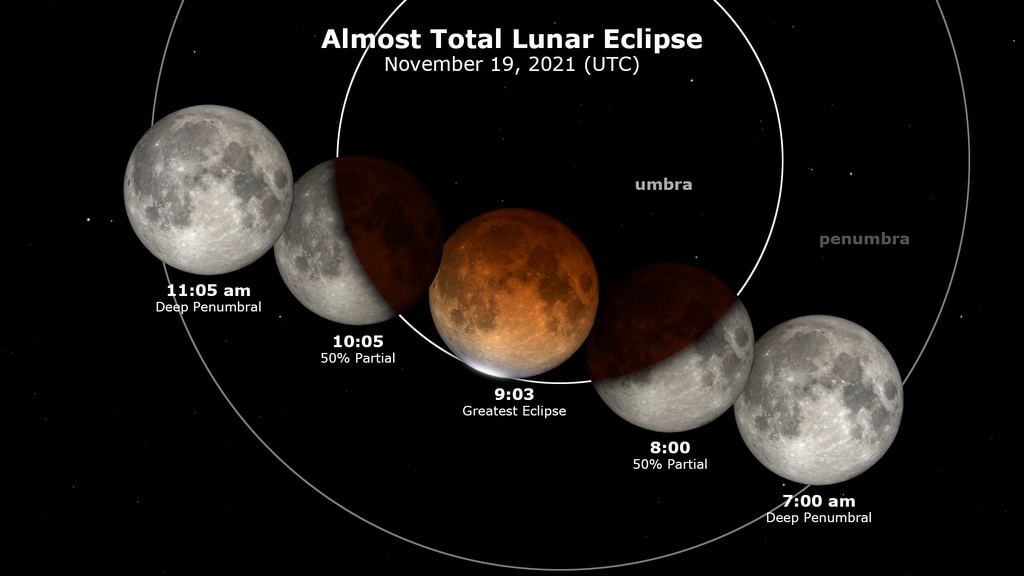Space lovers are in for a treat this week. Late Thursday night and into the early hours of Friday morning (in terms of US time zones), you'll have the chance to witness the longest partial lunar eclipse in 580 years.
And don't let the 'partial' part fool you – this lunar eclipse will be pretty much as close as you can get to a total eclipse, with more than 97 percent of the full moon cast into a red hue by Earth's shadow (NASA says 99.1 percent will be covered, whereas Griffith Observatory in Los Angeles says 97 percent).
At its peak, only a tiny fraction of the Moon on the bottom left corner will remain lit up.
And although it's not the first lunar eclipse this year – we saw a total lunar eclipse back in May – this is going to be a special one.
The entire event will last for just over six hours, and the Moon will spend a whopping three hours, 28 minutes, and 24 seconds passing through the darkest part of Earth's shadow (its umbra) – making it the longest partial lunar eclipse since 1441, and by far the longest this century.
Lunar eclipses occur when the Earth passes between the Sun and the Moon, casting its shadow over our lunar satellite.
The Moon doesn't go completely dark in the same way the Sun is blotted out during a total solar eclipse. Instead, some sunlight bends through Earth's atmosphere, giving the Moon an eerie red glow.
This red color gives the phenomenon its nickname of a 'blood moon'.
The near-total eclipse will be viewable across the night side of Earth, which includes North America, as well as Hawaii and parts of Russia and South America.
 (NASA's Scientific Visualization Studio)
(NASA's Scientific Visualization Studio)
Australia, New Zealand, Japan, China, and Southeast Asia will be able to see it on the evening of Friday, 19 November.
Those on the west coast of the US will have prime viewing conditions, as the Moon will begin to pass through the darker part of Earth's shadow at 11:18 pm on Thursday night PST (07:18 UTC), and leave it at 2:47 am on Friday morning in PST (10:47 UTC).
During this time, the Moon will be high in the night sky for easy viewing.
Those closer to the east coast will need to get up early and look low towards the western horizon. In EST, the best viewing will start at 2:18 am and end at 5:47 am on Friday morning.
You can see a full chart showing the best viewing times for your location here.
The November full moon is often referred to as a 'beaver moon', which is a name given by Native Americans based on the fact that traditionally November was the best time to trap beavers as they prepare for winter. According to NASA, it's also sometimes referred to as the frosty or snow moon.
Why is the November lunar eclipse so long?
So why is this partial lunar eclipse so lengthy? It's occurring just as the Moon is about to arrive at its apogee – the farthest point it gets from Earth in its orbit.
That means it's also moving at its slowest speed through its orbit and takes its sweet time passing through our planet's shadow.
For comparison, the May lunar eclipse was an hour shorter, lasting five hours and 2 minutes in total, and with the darkest part of Earth's shadow passing over the Moon for just two hours and 53 minutes.
 (NASA's Scientific Visualization Studio)
(NASA's Scientific Visualization Studio)
How to watch the November lunar eclipse
Depending on where you are, you'll either need to stay up later, or wake up early.
As mentioned above, the closer you are to the US west coast, the better viewing you'll have with the Moon right above you.
Those on the east coast will need to look towards the western horizon around dawn. Those on the other side of the planet in Australia, New Zealand, and the eastern parts of Asia, will see the eclipse in the evening, as the Moon is beginning to rise.
You'll clearly be able to see the event with your naked eye, and can use binoculars or telescopes if you want a closer view.
For those who won't be able to see the eclipse, or those dealing with bad weather, you can also view the event online via the livestream from the Griffith Observatory in Los Angeles below:
Unlike solar eclipses, you won't need any special gear to view the eclipse, as you're not risking eye damage by looking at the Sun.
But interestingly, lunar eclipses usually occur within a few weeks of a solar eclipse – and a total solar eclipse will happen on December 4. Unfortunately only those in the southern Ocean or Antarctica will get to see the full thing.
Still, this week's lunar eclipse is going to be a spectacular chance to get outside, wrap up in a blanket, and take a moment to enjoy a brief moment of astronomical alignment, and marvel at the long-reaching shadow cast by our home planet.



No comments:
Post a Comment